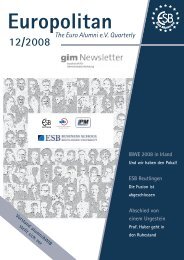Entwicklungen nach Fukushima - ESB-Radler
Entwicklungen nach Fukushima - ESB-Radler
Entwicklungen nach Fukushima - ESB-Radler
Sie wollen auch ein ePaper? Erhöhen Sie die Reichweite Ihrer Titel.
YUMPU macht aus Druck-PDFs automatisch weboptimierte ePaper, die Google liebt.
Carlos Rivera<br />
(MBA 2008)<br />
(USA) already filed for creditor protection and<br />
many believe Q-Cells and Conergy (both Germany)<br />
will follow soon;<br />
ß Suntech Power (the world largest PV manufacturer)<br />
has already announced losses for 2011.<br />
It is clear that the PV industry is currently undergoing<br />
a drastic consolidation. No sign of the expected solar<br />
boom after <strong>Fukushima</strong>’s accident.<br />
Thermoelectric (CSP)<br />
Even though this technology uses the sun power, it<br />
works much differently than PV. A special medium,<br />
such as oil, water or molten salt, is heated up by the<br />
sunlight. The heat in the medium is later used for driving<br />
a turbine and producing electricity.<br />
The main advantage of this technology lies within the<br />
relatively cheap storage system, that can be integrated<br />
easily: Projects Andasol 1, 2 and 3 in Spain already<br />
provide 6 hours of storage capacity; Gemasolar (Spain)<br />
is already capable of generating electricity for 24 hours<br />
continuously – just from solar power. This has enormous<br />
advantages for the electric power grid, since the<br />
dispatch of the energy can be planned. However this<br />
technology is currently more expensive than PV. And<br />
this is the reason, why several projects in the US have<br />
switched from CSP to PV, being Blythe Project (1.000<br />
megawatt output power) the most striking one. To improve<br />
commercial viability, the CSP industry is working<br />
hard on cost reductions, regarded pivotal as far as the<br />
competition against PV is concerned. The bankruptcy<br />
of Solar Millennium shows how difficult this market<br />
has become.<br />
Like PV, CSP has been drastically hit by reductions in<br />
the subventions from the Spanish Government (reducing<br />
feed-in tariffs and limiting the amount of projects)<br />
as well as from the US Government (the Loan Guarantee<br />
Program ended last September). Meanwhile, four<br />
big projects are being built in the US: Ivanpah (392<br />
Since completing his MBA in 2008, Carlos Rivera Willeke is working in the area of<br />
solar thermal power plants (CSP). Besides this professional interest, he pursues his<br />
hobbies cooking and soccer and spends time with his growing family.<br />
MW) by Brightsource, Solana (289 MW) and Mojave<br />
Solar Project (250 MW) by Abengoa and Tonopah (110<br />
MW) by Solar Reserve. Nevertheless, the future remains<br />
very unclear. Can CSP engage in effective cost reduction<br />
so that it can successfully compete? Like PV, there<br />
has not been a solar boom for CSP projects after the<br />
accident at <strong>Fukushima</strong>.<br />
Despite of the current negative environment, the future<br />
of the power generation belongs definitely to the renewable<br />
energies, in which solar energy will play a<br />
central role. The main question is, how fast can the<br />
required technologies be developed, principally in<br />
terms of grid stability and cost effectiveness.<br />
Illustration of a Concentrating Solar Power Tower Plant<br />
Copyright: U.S. Department of Energy / NREL 1996<br />
Illustration of a Concentrator Solar Power Plant<br />
(“Parabolic Trough Plant”)<br />
Copyright: U.S. Department of Energy / NREL 1996<br />
Schwerpunkt Erneuerbare Energien – <strong>Entwicklungen</strong> <strong>nach</strong> <strong>Fukushima</strong> 15






